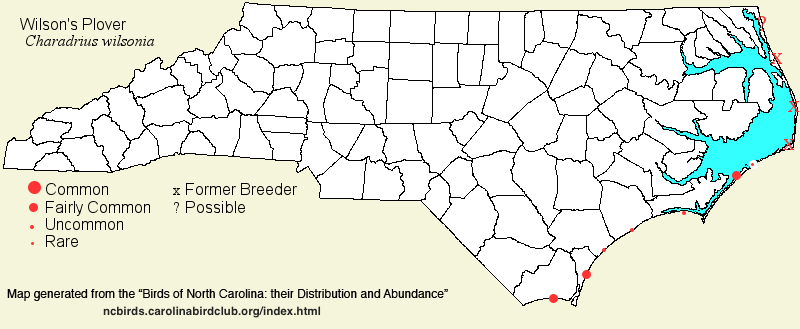 |  |
|
Wilson's Plover - Anarhynchus wilsonia CHARADRIIDAE Members: | Search Common: Search Scientific: |
|
|
|||||||
| General Comments | Compared with the Arctic tundra, few shorebird species breed along the Atlantic coast. The Wilson's Plover breeds on the Gulf and South Atlantic coasts of the United States, and its range overlaps with that of the more northerly Piping Plover mainly in North Carolina and Virginia. Unlike the latter species, which also breeds in the interior of North America, the Wilson's is strictly coastal, and any report away from that region is unusual and is usually scrutinized carefully for mis-identification, normally being rejected by editors for lack of, or poor, details. The species nests on sand flats, mainly near inlets, but it also nests on dredge islands and some natural estuarine islands. It forages mostly on upper beaches and moist sand, but at times forages at the ocean edge. It generally winters south of the Carolinas, but a few birds do and can overwinter along the central and southern coast. As would be expected for a beach-nesting species, breeding populations in North Carolina and in the United States are declining, owing to development, increasing human and vehicular use of beaches, and probably to an increase in predators such as cats, foxes, and raccoons. | ||||||
| Breeding Status | Breeder | ||||||
| NC BRC List | Definitive | ||||||
| State Status | SC | ||||||
| U.S. Status | |||||||
| State Rank | S2B | ||||||
| Global Rank | G5 | ||||||
| Coastal Plain | Summer resident, breeding, and rare winter visitor/resident, along the coast; slightly declining. Fairly common on the southern half of the coast, north to Ocracoke Inlet on Core Banks; uncommon on Ocracoke Island. Also breeds in small numbers along the northern shoreline of Cedar Island (Carteret), which fronts Pamlico Sound and not the ocean. Now rare on Hatteras Island (mainly at Hatteras Inlet). Essentially absent as a breeder now north of this inlet. Also, a few birds linger into winter at one to several sites, and there is occasional overwintering, mainly at Bird Shoal in Carteret and the eastern end of Shackleford Banks in that county. Locally notable numbers after the breeding season at some locales, mainly at Bird Shoal at Beaufort and on Portsmouth Island, probably a mix of migrants from Virginia and Maryland, and family groups from North Carolina nesting birds. There appear to be no Tidewater records, and but one farther inland in the province -- at Mount Olive on 18 Sep (year not given in Pearson et al., 1959). This record has not been reviewed by the NC BRC. Primarily mid-Mar to mid-Oct, with scattered records for all winter months. Peak counts: 112, New River Inlet (Onslow), 21 Jul 2021; 100, Beaufort (probably Bird Shoal), 2 Aug 1980; many other counts of 100-120 from this site. Breeding population in 2004: 235 pairs; 2007: xxx pairs (NC Wildlife Resources Commission database). Winter peak: 6, eastern end of Shackleford Banks, 26 Jan 2020. | ||||||
| Piedmont | Accidental: two reports, one with published details -- from Franklin, 30 Aug 1975 [Chat 40:65 link]. Another was seen by a group of birders at Winston-Salem, 26 Aug 2006 (The Piedmont Birder newsletter), but no description was provided, and the photo in the newsletter was of a bird from a coastal location. Neither of these reports has been reviewed by the NC BRC. | ||||||
| Mountains | No records. | ||||||
| Finding Tips |
Unfortunately, many of the best areas to see this species are relatively inaccessible. There are healthy breeding populations on Portsmouth Island, Core Banks, Bird Shoal, and Bald Head Island; all are accessible only by boat. Good places to find this species without the need for a boat are along the beaches at Fort Fisher, near inlets at the Brunswick beaches (such as Sunset Beach, Holden Beach, and Long Beach), at the northern end of Wrightsville Beach, and at the south end of Ocracoke Island. Single birds are occasionally seen north of Hatteras Inlet, but you cannot expect to see one north of Ocracoke Island. *** | ||||||
| Attribution | LeGrand[2023-03-10], LeGrand[2021-11-07], LeGrand[2020-04-18] | ||||||
| NC Map Map depicts all counties with a report (transient or resident) for the species. | Click on county for list of all known species. |
| NC Breeding Season Map Map depicts assumed breeding season abundance for the species. |  |